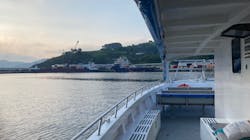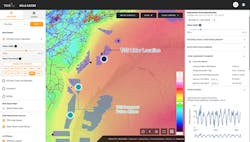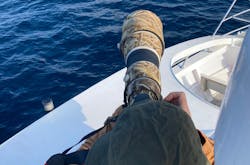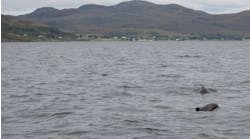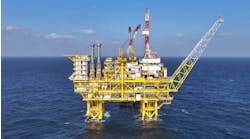Editor's note: This story first appeared in the July-August 2022 issue of Offshore magazine. Click here to view the full issue.
By Ariana Hurtado, Editor and Director of Special Reports
Environmental studies, assessments and regulations are an important and necessary part of the project planning and execution process. The challenge for both the offshore oil and gas and wind energy industries is that these studies can take years to complete, leading to extended project timelines, delayed commissioning and increased costs.
More developed countries have stricter environmental legislation, and this can cause more delays to an offshore project compared to other countries with less or more relaxed environmental regulations. Obtaining approval and ensuring regulations and guidelines are being met can sometimes result in timelines having to be modified repeatedly. Less restrictions means operators, developers and suppliers can set clearer project timelines and adhere to them.
In addition, there is a set window of availability with suppliers, and an environmental delay can result in a need to reconcile these supply chain contracts and timelines.
The environmental restrictions are increasing as more data and information is gathered offshore, and environmental legislation is adapting to the new data. Fortunately, this information also allows offshore project leaders to become more accurate with expected environmental impacts during their planning phase.
For the oil and gas industry, it seems more information can sometimes lead to more slow-downs or halted projects by environmental groups. But with the offshore wind sector, it appears the problem is the opposite—a lack of information altogether.
Surveys and permits
Shell is currently engaged in a South African court in an effort to continue its seismic surveys in the Indian Ocean. Environmental and community groups in the Eastern Cape province won an urgent interdict to halt the surveys in December 2021, stating they were not properly consulted by Shell and the government before permission was granted to conduct the survey. The environmental groups are now asking the court to permanently end the surveying operations. Shell submitted findings to the court that the surveys were not harmful to marine life, but experts testified that the seismic surveys could have an adverse impact on the marine environment. To that argument, Shell and government lawyers said seismic surveys have been conducted for many years with no recorded occurrences of harm to marine animals. They also argued that the government had taken all factors into account when initially granting Shell approval to conduct the surveys.
Most offshore development projects start with an environmental study, consultation and/or assessment. The question for the offshore industry, and seismic survey firms in particular, is how they can best utilize the latest technologies and data gathering methods to comply with and fulfil new environmental mandates.
Gabriel Rolland, TGS’ director of HSE, recently spoke with Offshore about the emerging environmental constraints on offshore development. “As standard practice, TGS continues to identify, manage and mitigate all potential impacts on the environment by commissioning environmental impact assessments, engaging with stakeholders and local communities, and monitoring environmental performance on all geophysical and geoscience operations,” he said.
Despite these efforts, environmental permitting processes can stall project commencement and completion dates as well as impact overall costs.
“Delays and uncertainty due to environmental reviews and evolving regulations have made the process of obtaining geophysical/geoscience permits challenging,” Rolland added. “While the impacts vary by location, environmental permitting timelines and restrictions have increased, and this has impacted project timelines, costs, resources and operational efficiency.”
Through the EnerGeo Alliance, a global trade association to the energy geoscience industry, and other industry trade organizations, TGS said it engages with permitting agencies and regulators to stay informed and retain the ability to acquire permits effectively while ensuring that the company continues to mitigate potential impacts on the environment.
Offshore US regulations
The US Department of the Interior’s Bureau of Ocean Energy Management (BOEM) oversees the development of US Outer Continental Shelf energy and mineral resources to ensure that those operations are performed so in an environmentally and economically responsible manner.
“BOEM ensures that environmental protection—informed by the best available science and consistent with requirements of laws, regulations and lease terms—is a foremost concern and an indispensable consideration in BOEM’s decision-making,” Bill Brown, BOEM’s chief environmental officer, told Offshore.
So what does the review and approval process look like between an operator and BOEM before production can begin?
“A company must file an exploration plan before drilling any wells,” Brown explained. “The exploration plan is then subject to a technical and environmental review by BOEM and regulatory supervision by the Bureau of Safety and Environmental Enforcement. Once a discovery is made and the company is interested in developing, it must file a development and production plan for BOEM to again conduct a technical and environmental review before production could begin.”
Based on these reviews, BOEM may add requirements to mitigate potential environmental impacts as conditions of approval of exploration plans or development and production plans.
“For major facilities, BSEE [the Bureau of Safety and Environmental Enforcement] conducts an onsite inspection before allowing production to begin,” Brown said. “Often this is a joint inspection with the US Coast Guard. Air emissions permits and water discharge permits must also be obtained as required by law. BSEE has inspectors that fly daily to offshore sites to conduct safety and environmental inspections.”
BOEM issues environmental assessments for both oil and gas operations as well as renewable energy projects.
In late June, BOEM released a draft environmental impact statement (DEIS) for the proposed Ocean Wind 1 wind energy project offshore New Jersey. The DEIS for the proposed offshore wind farm analyzes the potential environmental impacts of the proposed action described in Ocean Wind’s project plan for constructing and operating an offshore wind energy facility. During a 45-day comment period, which concludes Aug.8, BOEM will conduct three virtual public meetings and accept comments on the DEIS. The input received via this process will inform preparation of the final EIS. BOEM will use the findings of the EIS to inform its decision on whether to approve Ocean Wind’s proposed project. BOEM expects to complete the review of at least 16 plans to construct and operate commercial, offshore wind energy facilities by 2025.
In early May, BOEM also completed an environmental review of potential impacts from offshore wind energy leasing activities in the Humboldt Wind Energy Area, located 20 miles offshore northern California, and issued a finding of no significant impact.
Offshore wind assessments
Environmental reviews and feedback from these agencies are significantly impacting offshore wind project planning, but it’s very site specific, according to Mario Castellanos Diez, head of the Environment Department at Saitec.
Saitec provides concrete floating foundations to the global offshore wind industry, and Diez explained it can be difficult to set a general standard for all offshore wind farms because project planning varies greatly depending on the location/country and the environmental regulatory frameworks in each region.
“Environmental reviews are causing delays in the time schedule of some projects, because the deeper you go in the sea, the more unknown the environment is there,” he said. “So you need comprehensive studies in order to know the biodiversity there. For the floating offshore wind farms, since they are several kilometers away from the coast, you are in a place where you know almost nothing about what's in the sea bottom [or] what birds are migrating [there].”
During a consultation with environmental authorities, many developers and service providers are informed that there is a lack of information about a particular offshore area. Oftentimes, these environmental authorities have background information onshore, or on the coast or a few kilometers from the coast—but not in deepwater, Diez explained. With onshore projects, there are larger backgrounds of data and developers know what to expect in an area.
“But when you go to the offshore world, everything is new for the developers and for a great part of the environmental authorities,” he said. “When you are going very deep, it is a challenge because you don't know what to expect. It adds uncertainty to the projects. For instance, during your environmental assessment, you can find species that are vulnerable in the sea bottom or you can find that you are inside or within a corridor of the migratory bats or birds, and those are impacts that are not foreseeable because it's a very unknown area. That's the main impact on the project planning; you don't know what to expect.”
For developers, data gathering is critical so they can be more confident about the conditions they set and the timeline of a project, and so they can reduce project uncertainties, Diez said.
Environmental assessments and authorities also can affect the procurement phase.
“You don't know when you have to start your construction, when you have the green light for the marine deployment or some other stages of the project,” Diez said. “You spend a great amount of time gathering data and waiting for the outcome.”
The environmental authorities heavily affect the project planning process, but not so much in the operations, according to Diez. Each country and environmental impact statement requires different mitigation measures. The impacts during this part of the project “depend on the country and how strict or how relaxed” it is with the environment and its mitigation measures, he said. The main restriction during offshore wind operations could be the migration of birds during certain seasons and the potential loss of production due to bird protection and mitigation measures, he added.
The duration of environmental studies varies as well, and that duration can differ by location or country-specific regulations. It also can differ by the type of data an organization is trying to gather. For example, Diez said bird studies take one to three years to allow enough time for researchers to understand how the birds behave and their migration patterns in the deepsea area.
“It's difficult to make a proper plan or prepare timelines if you don't have the certainties about the environmental impacts; you need a lot of time,” Diez said. “The environmental studies take a lot of time, take too long to make planning in one or two years, and when it comes to the birds, it takes too, too long.”
Researchers are also looking into the ways in which vertebrates get attached to the chains of the mooring system and their impact upon those systems. This type of marine life activity can cause the chains to get heavier over time and affect operations, Diez explained. Impacts such as this occur during the operational phase.
“Floating wind facilities are a newcomer in the market. The environmental impact of offshore wind development is unknown. There are some impacts that are expected, but nobody knows about it with certainty. That is why pre-commercial projects are so important” Diez concluded. “Some environmental groups have different opinions. It's important to get them involved in the earliest stage of the project, letting them be part of the shaping of the project, because otherwise you can have later conflicts with them.”
